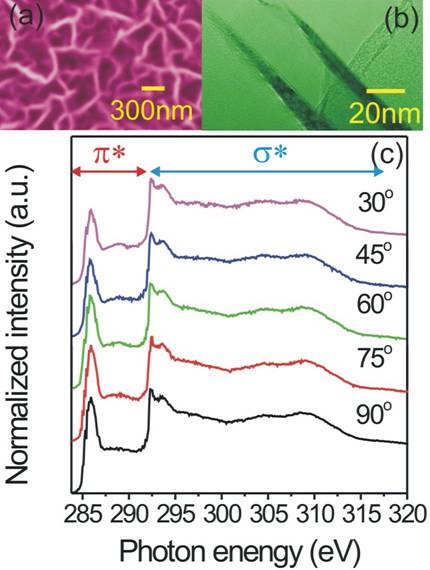Highly anisotropic graphene materials such as aligned carbon nanotube (CNT) forests, oriented CNTs arrays have been universally considered as an excellent electrode for electroanalysis because they make predominant use of the highly reactive edge planes in contrast to the nearly inert basal planes. However most aligned CNTs contain metal catalysts, which are also a possible source of their electrocatalytic activity. Therefore the extent to which the electrocatalytic properties are affected by the graphene edge planes or the metal impurities introduced during the fabrication process is not known.
Multilayered graphene nanoflake films (MGNFs) could provide an answer to this argument since they consist of a large amount of vertical graphene edges and they are fabricated without a metal catalyst. Scientists from University of Ulster, Dr P. Papakonstantinou and Dr N. Shang have been working closely with Diamond scientists to investigate the degree of orientation by NEXAFS in the produced graphene nanoflake systems. They exclusively demonstrate that the termination of the film surface by a plethora of graphitic edge planes is responsible for the high electrocatalytic activity toward the sensing of various biomolecules including the dopamine neurotransmitter.
In detail
Recently graphene has been considered as a rising material star and has received intensive attention due to its novel properties. At the University of Ulster a MGNF platform has been fabricated by a novel microwave plasma enhanced chemical vapour deposition strategy on Si and consists of 1-20 nm thick 2 dimensional graphenes with 2 nm thick edges as shown in the figure below. The team from Ulster used Diamond to determine the alignment of graphene flakes and their electronic structure. A comparison with analogous ordered systems such as vertically oriented nanotubes and highly oriented pyrolytic graphite confirmed the predominant alignment of the graphene flakes and graphitic edge planes on the surface.

(a)SEM (b) TEM of the graphene nanoflakes. (c) Angle dependent NEXAFS spectra of MGNFs
Overall it was discovered that the graphitic edge planes (not the metals) play a critical role in the fast electron transfer kinetics and the high electrocatalytic activity. This work has been published in the Journal of Advanced Functional Materials.
Pagona Papakonstantinou, who led the Ulster group, says "This novel edge plane based electrochemical platform with the high surface area and electroactive surface offers great promise for creating a revolutionary new class of nanostructured electrodes for biosensing, fuel cells energy conversion applications that could replace their carbon nanotubes counterparts".
Professor Sarnjeet Dhesi, Principal Beamline Scientist on I06 adds, "This work clearly demonstrates the unique insights that can be gained using polarised soft x-rays on I06. The improved control of the x-ray polarisation on I06 now allows even more subtle effects to be studied."
Naigui Shang, Pagona Papakonstantinou, Martin McMullan, Ming Chu, A. Stamboulis, Alessandro Potenza, Sarnjeet S. Dhesi, and Helder Marchetto, "Catalyst-Free Efficient Growth, Orientation and Biosensing Properties of Multilayer Graphene Nanoflake Films with Sharp Edge Planes", Advanced Functional Materials
DOI: 10.1002/adfm.200800951
Online: Oct 17 2008:
Diamond Light Source is the UK's national synchrotron science facility, located at the Harwell Science and Innovation Campus in Oxfordshire.
Copyright © 2022 Diamond Light Source
Diamond Light Source Ltd
Diamond House
Harwell Science & Innovation Campus
Didcot
Oxfordshire
OX11 0DE
Diamond Light Source® and the Diamond logo are registered trademarks of Diamond Light Source Ltd
Registered in England and Wales at Diamond House, Harwell Science and Innovation Campus, Didcot, Oxfordshire, OX11 0DE, United Kingdom. Company number: 4375679. VAT number: 287 461 957. Economic Operators Registration and Identification (EORI) number: GB287461957003.